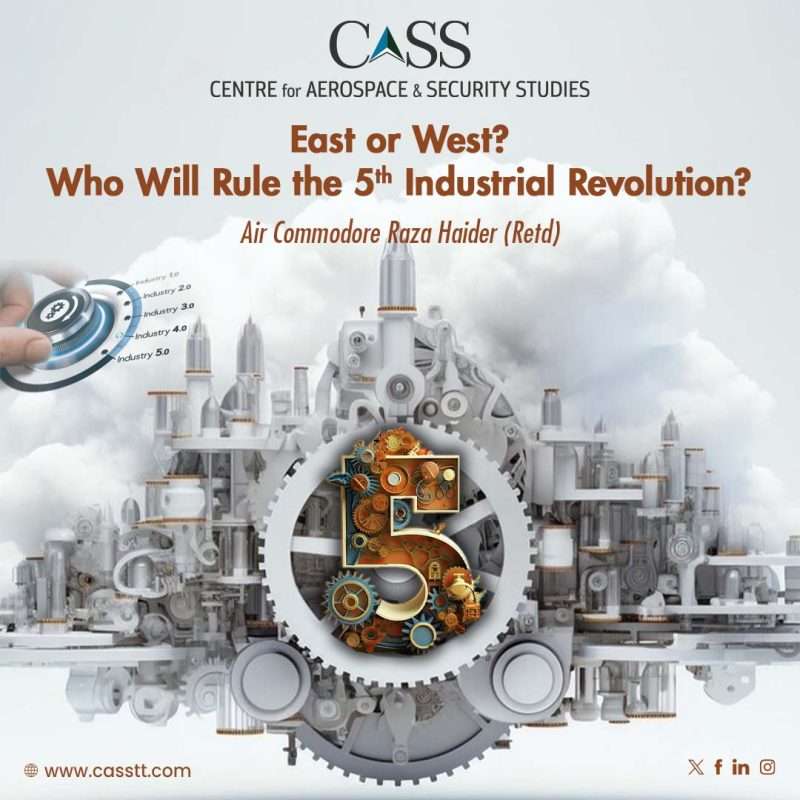The world economy saw a ‘great divergence’ as a result of the first two Industrial Revolutions (IR-1 and IR-2) between 1750 and 1950 AD. The economic shift occurred from East to West as a result of industrial development by Western European nations led by Great Britain. The key to their success was the use of then-new technologies like steam power, mechanisation, automobiles, railways, telegraphs or electricity at every level of industrialisation. This technological trend gave rise to the 3rd Industrial Revolution which was led this time by the United States (US) in the 1960s consisting of new inventions like the computer and internet which not only revolutionised every aspect of life but also expanded the industrial economy’s proportion in the total economy.
Currently, we are experiencing the 4th Industrial Revolution (IR-4), which is being driven by the US and dominated by emerging technologies such as Artificial Intelligence (AI), robotics, big data, Internet of Things (IoT), cloud computing, cyber security and augmented reality. While the impact of these technologies on industry, military, economy, and social life is becoming evident, discussion on the 5th Industrial Revolution, or IR-5, has already started. IR-5 would be centred on the co-working of humans and high-tech machines or robots in all fields of life including industries, but the question arises who will be the leader of this upcoming industrial revolution?
The US and Western European countries that benefited from the first four industrial revolutions appear to have an inherent advantage because of their knowledge base, robust economy and experience, which can facilitate higher adoption of new skills, training, and technology. More significantly, these countries are aware of the importance of digital economies and are doing so to gain an advantage in emerging digital value chains. However, accumulation of wealth and experience cannot be the only reason to sustain technological and economic sovereignty till the time emerging technologies are developed and integrated into their industry. As technology has now become a key factor in determining national power, there are indications that the economic divide between the countries who ‘have’ technologies and those who ‘have not’ is increasing. Some countries are falling behind while few countries especially in East Asia are emerging as new leaders.
East Asia began to embrace technology as a key instrument to boost economic progress in the post-1960 era. This mainly includeD China, Japan, Hong Kong, Singapore and South Korea. Indeed, this growing economic divide known as the ‘East Asian Miracle’ may mark the start of yet another ‘great divergence.’ In recent decades, East Asia has transformed into a hub not only for the manufacturing of high-tech products like smartphones, telecommunication equipment, or semiconductors but also as a leader in the development of autonomous robots, drones, Electric Vehicles, Next Gen IT, Cloud Computing, 3D manufacturing machines and artificially intelligent products which is only possible through heavy investments, consistent policies and incentives for investors, skilled human resource and entrepreneurship.
For example, China is primarily focused on becoming a global leader in ten high-tech industries by 2025 including aerospace, high-speed railway, nanomaterials, IT, and electric vehicles emphasising the incorporation of Artificial Intelligence (AI), robots, and other nascent technologies into manufacturing supply chains aligning them with the requirements of the Next Industrial Revolution. Similarly, in Hong Kong, there are 17 programmes under the Innovation and Technology Fund (ITF) with funding of USD 32.8 billion to support R&D, facilitate technology absorption, develop new talent, support start-ups, and foster an IT culture in the country. Similar programmes are in progress in other East Asia countries like Japan, South Korea, and Singapore. Considering all these technological developments, it is envisaged that while the US is currently leading the world in innovation of emerging technologies; East Asian countries, with their highly developed digital economies, R&D investments, technology firms, and innovation systems are emerging as potential leap froggers. Therefore, it is expected that East Asia will share leadership of the 5th Industrial Revolution with the US, as the region is highly committed to adopting new technologies and creating institutional support for digital breakthroughs in their trade, industry, and society.
In the context of Pakistan, adopting emerging technologies is the only viable solution for a proactive strategy aimed at attaining equitable, sustainable, and innovation-driven industrial growth. As a way forward, three suggestions are made. Firstly, STEM (Science, Technology, Engineering, Maths) education ought to be mandated in schools so that the future generation can learn about and be interested in new technologies, as well as have the opportunity to digitise in the future, even in non-technical industries like business, education, healthcare, and agriculture. Secondly, awareness campaigns are needed for decision-makers to encourage technology-driven start-up programmes for the digital economy. Finally, a national industrial policy centred around indigenisation and digitalisation (like ‘Made in China 2025’) is needed to enable the industrial sector to play a major role in the country’s overall economic advancement.
To conclude, while earlier industrial revolutions were led by UK and the US which significantly contributed to their economic power, it is envisaged that the next industrial revolution would be shared by the US and East Asian nations, given the scale of R&D and digital breakthroughs in those eastern countries. Pakistan’s industrial sector needs to be reorganised and digitalised through a comprehensive ‘Industrial Digitalisation Policy’ to take full advantage of opportunities through systematic innovations and to develop our human resources to handle future industries.
Raza Haider is currently serving as Director (Emerging Technologies and Aerospace Industry) at the Centre for Aerospace & Security Studies, Islamabad, Pakistan. The article was first published in Europe Today. He can be contacted at: cass.thinkers@casstt.com.




